

Vol. 41 (Issue 10) Year 2020. Page 20
ZALUNINA, Olga M. 1; KASYCH, Alla O. 2; TSALKO, Tetiana R. 3; NEVMERZHYTSKA, Svitlana M. 4 & FEDORIAK, Ruslan M. 5
Received: 02/12/2019 • Approved: 28/02/2020 • Published 26/03/2020
ABSTRACT: The article investigates theoretical, methodological and analytical aspects of developing the modernization processes. To conduct a comprehensive analysis of modernization processes, the author proposes the analysis method that requires the identification of the stages of analysis, systematization of the existing ones, and suggests new indicators. Based on the developed methodology, analytical studies of the features of modernization in different countries are conducted in the context of its separate types (economic, social and environmental). The complex analysis results in the grouping of countries by the level of the activity of modernization processes and the separation of the basic regularities. |
RESUMEN: El artículo examina los aspectos teóricos, metodológicos y analíticos de la evaluación del desarrollo del complejo de edificios del país. Para realizar un análisis del desarrollo del complejo de edificios del país, el autor propone un método que requiere la determinación de las etapas de análisis. Con base en la metodología desarrollada, se realizan estudios analíticos para evaluar el desarrollo del complejo de edificios del país en el contexto de componentes individuales. Para cada componente, se define un conjunto de indicadores y criterios para evaluar el nivel y el ritmo de desarrollo. El resultado del estudio es un enfoque metodológico para determinar los criterios para evaluar el desarrollo del complejo de edificios del país. |
The development of the construction complex is a prerequisite for the effective functioning of all other elements of the economic mechanism of the state. The condition for the development of the construction complex involves a process of the quantitative and qualitative changes in material objects in the time interval, which are manifested in improving the production system, improving the management of production flows, introducing new construction technologies, and designing new organizational structures. The process of developing the construction complex forms a functional unity in obtaining the result – the reproduction of buildings and structures for industrial and non-industrial purposes. Close economic, technical and technological ties of the elements of the construction complex characterize the development. This leads to wide range analysis areas of the construction complex development, during which various indicators and criteria are used. Thus, the following problems of estimation of the construction complex development take place:
A theoretical problem – implies the construction complex functioning as a comprehensive transformational process of the whole integral system including manufacturing, technological, economical, politic, social, and innovative interconnections and interactions; the concept model of the construction complex development is missing for now;
A methodological problem – the current methodological approaches to the construction complex development estimation do not allow for substantive evaluation of the done changes;
An empiric problem – the construction complex functioning can be evaluated in terms of probability of breaking crisis occurrence due to the stochastic nature of the environmental impact.
In connection with this provision, it can be stated that the formation of criteria for evaluating the development of the state construction complex is an urgent task, allowing to assess its development.
The experience of fundamental and applied research, which provides the scientific basis for a study on economic growth, includes several areas for assessing the development of the state construction industry.
The approaches to assessing the development of the construction complex are described in many scientific papers. The assessment is carried out based on the analysis of production activities and technologies. The works of Gort, M. A. (1982) and R. Johnston (1966) present the impact of individual technologies on the development of the state construction complex. The approach is based on a study of the dominant influence of technology on the development of the state construction complex. The number of technologies and the intensity of their use is the main motive factor for development. The model of economic growth presented in the discussion paper on entrepreneurship, growth and public policy (G. Polat, 2010) confirms the scientific idea of the impact of technology on the production in construction.
In spite of the fact that the role of state gradually decreases in the conditions of the market economy, the functions of the state institutes remain determinative concerning the territory development. A. O. Kasych persists these attitudes in in her works (Kasych, A.O., 2011, Kasych, A.O., 2013).
The assessment of the development of the state construction complex may also be associated with the assessment of the resource supply of the construction industry. The model presented in the works of G. Polat and U. Donmez (2010) on the distribution of resources argues such a statement. However, there are serious gaps in many sectors of construction management, since the compliance with the nature and characteristics of the industry has been little taken into account in the theory of the development and management of the construction complex (Seymour, D. Crook, D. and Rooke, J. 1997).
In his works, Myrdal G. (1972) analyses the features of the economic growth of countries taking into account the influence of territorial factors, which include construction. The researcher argues the conclusion that the difficulties on the territory development relate to the social contradictions and the backwardness in all life areas. Therefore, the market economy tools do not work on the scheme of the orthodox theory. The construction complex associated with a wide range of industries is directly dependent on many areas of life, which tend to decline in real time.
The recommendations for assessing the development of the state construction complex existing now are not fully presented. First, they are not obtained based on a systematic study, therefore, the recommendations have no concept; secondly, they are not comprehensive, which would lead to the development of the theory of developing the construction complex. Therefore, an additional comprehensive methodological research is needed in this area.
The purpose of this study is to develop a methodological approach to determining the criteria for assessing the development of the state construction complex.
Under the criterion for assessing the development of the construction complex, it is necessary to understand the quantitative or qualitative value of the parameters characterizing the functioning of the construction. The task of forming the criteria for assessing the development of the construction complex cannot be solved by traditional methods based on the established disciplinary approaches. The interdisciplinary aspect has increased, because the long-term growth rates of the economy of the territory are determined not only by the growth rates of production factors, but also by the rates of their change in the time range.
The construction complex includes the constituent elements associated with industrial, technological, operational and organizational activities. Such a structure of the construction complex obliges to assess the development of the listed components.
Among the methodological approaches to assessing the development of the construction complex of the country there are two:
The first approach is based on the analysis of production factors and provides for the analysis of industrial and technological data (Dougherty, C., and Dale W. J., (1996), Seymour, D. Crook, D. and Rooke, J. (1997), Zombart, V. (2005).
The advantage of this approach is the timely identification of opportunities that open up for the construction industry and the development of technology.
The disadvantages include poor attention to the macro environment. Nevertheless, the influence of the macro environment on the building complex is determined by the specifics of the industry. The most important parameters of the economy should be constantly monitored and predicted. Among them, the following ones are significant: the rate of inflation or deflation; the level of employment of labour resources; the international balance of payments; the interest and tax rates; the size and dynamics of the gross domestic product; the labour productivity, etc.
The second approach is based on the economic concept of the country development and provides for the analysis of economic indicators [Zhao Zuoquan (2006), Blaug M. (2008), Ivanova, Yu.V. (2011).
The advantage of this approach is the forecasting of macroeconomic indicators that reflect the economic situation in the country.
The economic concept of a country development depends on the business activity index, unemployment rate, inflation rate. When the state economy shows the growth, we should expect a rise in construction. Most often, economic growth is accompanied by an increase in demand for construction products, a gradual decrease in unemployment, and an increase in business activity.
The disadvantages of the analysis of economic indicators include limiting the time frame. Analysis of economic indicators for a short period can be focused only on those elements that critically affect the current functioning of the construction complex. Analysis of indicators in the long forecast period does not allow investigating the general nature of the external environment.
The essence of the proposed methodological approach to the formation of criteria for assessing the development of the construction complex takes into account the first and second approaches. At the same time, the sequence of actions proposed by the approach is expressed with the following algorithm:
1. Identification of factors affecting the development of the building complex of the country;
2. Formation of indicators characterizing the functioning of the construction complex of the country, based on the identified factors;
3. Analysis of the regression of relationship between the indicators characterizing the functioning of the construction complex of the country;
4. Formation of the criteria for assessing the development of the country construction complex.
At the first stage, in order to identify factors of influence, it is necessary to consider the constituent elements associated with: 1) production; 2) technological; 3) operational; 4) organizational activity of construction.
1. The production component is a structure. The production structure is a spatial form of organization of the production process, which includes the composition and size of production units, the forms of their interconnections among themselves, the ratio of units in capacity (equipment capacity), the number of employees, and the placement of units in the territory. The production component of the building complex is characterized by the composition; the size of production units; the degree of their proportionality; rationality of accommodation on the territory; sustainability of production relationships; influence on the rhythm and speed of production. The main elements of the production component include: a) technical preparation of construction; b) material and technical base of construction; c) construction flow parameters; d) placement of machines and mechanisms on the construction site.
2. Preparation of technical construction is a part of the construction life cycle and includes:
- development of a feasibility study for the construction of a facility, selection of a construction site, development of tasks and technical conditions for design;
-determination of the composition of construction and installation facilities for the construction of facilities, the creation and expansion of their production capacity;
-preparation of a plot for construction;
-creation of access roads and external communications serving the built-up areas.
The material and technical base of the construction provides the building complex with resources, includes enterprises and farms of the construction industry, which is under the authority of the construction and installation organizations and industrial enterprises. In a broader interpretation, the material and technical base of construction is the totality of all industrial sectors related to construction.
The parameters of the construction flow characterize the construction units, plants and enterprises that operate rhythmically and in concert.
The construction flow parameters include the following elements: the flow structure and the nature of the development over time flow; the duration of the operation of the flow; the direction (horizontal; vertical; stepped); the flow rhythm, the flow rate; the period of deployment of the stream, the step of the stream.
These characteristics describe the flow, its construction and features of the organization of this flow.
The placement of machines and mechanisms on the construction site takes into account: the safe working conditions of mechanisms; the factors of the influence of the installed mechanism on the work of other mechanisms located in its area of operation or in adjacent areas; the compactness in the arrangement of mechanisms, entrances, warehouses of materials and finished products, their uninterrupted delivery; the complexity of the material and financial costs for the installation of mechanisms and their further operation; the placement (binding) of cranes and elevators.
The placement of machines and mechanisms on the construction site affects the conceptual scheme of grouping the construction complex. This is argued by the Zalunina, O. (2014).
2. Technological component is the ratio between the active part of fixed assets (working machines, equipment, etc.). In addition, their passive part (buildings, structures, etc.). The technological component of the construction complex includes the technology of construction processes, which considers the theoretical foundations, ways and methods of performing the construction work in order to obtain products of the required quality. Processing of building materials should also be carried out using the appropriate technologies. This affects the qualitative change in the construction products of its state, physical and mechanical properties, geometrical dimensions, etc. The same element includes the construction of buildings and structures, which defines the theoretical foundations and principles for the practical implementation of certain types of construction, installation and special works.
The main elements of the technological component include: a) the design and composition of project documentation; b) engineering and economic developments in construction; c) methods for calculating calendar construction plans; d) workforce optimization algorithms; e) the design of building master plans; f) the sequence of calendar development; g) the design of temporary buildings and the design of warehouses; h) the design of temporary power supply and the design of temporary heat supply.
In this component, all elements are grouped according to the optimal technological and organizational conditions for the implementation of construction processes, ensuring the release of construction products in the planned period with minimal use of all types of resources.
3. The operational component is a set of technical, space-planning, sanitary-hygienic, economic and aesthetic characteristics of the building, causing its performance. The construction structures must meet the requirements for the buildings and structures in terms of durability, fire resistance, industrialization, unification, etc., because they perceive power and other influences and transfer them to the underlying structures, then to the foundations. The main elements of the operational component include: a) regulatory and technical support for the organization of construction; b) supervising and controlling the progress of construction; c) accounting, reporting and quality control in the construction; d) identification of hazardous areas; e) technical supervision, acceptance of objects into operation.
Elements of the operational component are a set of indicators characterizing the operational capabilities of the structure. They are characterized by the ability to maintain quality even with partial destruction or breakdown of individual elements because of exposure to natural and man-made factors.
4. The organizational component is the organization of production of construction. The organization of production of construction includes a set of organizational measures that ensure the most efficient use of labour, machines, mechanisms, materials, which results in successful fulfilment of production goals, commissioning of construction projects in a timely manner, with minimum labour and material costs and with high quality of work. This interconnected training system includes: a) the performance of certain types of work; b) the establishment and maintenance of the general order, priority and deadlines for the performance of work; c) the supply of all kinds of resources; d) ensuring the effectiveness and quality of the types of work or construction of the facility.
A large number of factors influence each component of the building complex.
The nature of the effect may be:
passive (P1) which does not depend on the production process;
active (A2) which varies according to the production process;
systematic (S3) which is constantly present;
periodic (P4) which appears with a time interval;
episodic (E5) which appears sometimes.
We structure the entire list of factors for each component, taking into account the nature of the influence (Table 1).
As a result of the first stage, we present and structure the influences that are the result of a wide range of interrelated actions, which manifest themselves for a long time not only in the construction complex, but also in the related areas of construction activities. The presented factors allow preparing a theoretical basis for the methodology for assessing the development of the construction complex.
At the second stage, it is advisable to determine a set of indicators that will allow an analysis of the features of the development of the construction complex. Thus, the European Central Bank uses the methodological approaches that are based on the use of both relative and integral indicators, in particular: the unit cost of construction (m2/ Euro); indicator of the implementation of the regulatory framework (100 is the highest score); an indicator of entrepreneurial freedom of subjects (100 is maximum); level of transaction costs (%).
These indicators are not sufficiently informative and do not allow for a detailed analysis of the development of the country construction complex.
That is why it is proposed to use the previously presented classification of factors (Table 1) and to systematize key indicators on its basis (Table 2).
The indicators characterizing the production component allow to analyse data on costs in the construction and reflect the technical characteristics of the equipment, the intensity of the production process, the characteristics of existing vehicles, sources and prospects for the supply of electricity, steam, hot and cold water, compressed air, gas and other types of energy and fuel; standards for materials, fuel, energy, tools.
The indicators characterizing the technological component allow estimating the progressiveness of technological processes in the construction through the share of innovative processes. The share of innovation processes characterizes the progressiveness of the construction complex, reflecting the share of innovations to the total volume of construction products. The higher the proportion of innovative technologies and the lower the cost of construction of buildings and structures are, the more capital investments in construction are more progressive and effective. Increasing the share of innovative processes contributes to the growth of technical equipment and an increase in the production capacity.
The indicators characterizing the operational component allow defining a set of measures to ensure comfortable and trouble-free use of buildings for specific purposes during the regulatory period. An operational period has the most significant impact on the quality of the building, since it is the final and longest in time. At the same time, during the operation period, there may be drawbacks made during the design and construction. Operational services in this case should eliminate these shortcomings. The indicators characterizing the operational component are an additional mechanism in solving these problems.
Table 1
Structuring the factors affecting the
development of the construction complex
№ |
Block |
Influencing factors |
Development impact: |
||||
1 |
Industrial |
Technical construction preparation |
|
|
|
|
|
P1 |
|
|
|
|
|||
Material and technical base of construction |
|
A2 |
|
|
|
||
Construction flow parameters |
|
|
S3 |
|
|
||
Placement of machines and mechanisms on the construction plan |
|
|
|
P4 |
|
||
2 |
Technological |
Organization of design and composition of the project documentation |
P4 |
|
|
|
|
Engineering and economic development in construction |
P4 |
|
|
|
|
||
Methods for calculating calendar construction plans |
|
|
|
|
E5 |
||
Workforce optimization algorithms |
|
|
|
|
E5 |
||
Designing general construction plans |
|
A2 |
|
|
|
||
Organization of the work of transport and construction machines |
|
|
S3 |
|
|
||
The sequence of the development of the schedule |
|
|
S3 |
|
|
||
Temporary building design |
|
|
|
|
E5 |
||
Warehouse design |
|
|
|
P4 |
|
||
Temporary power supply design |
|
|
|
|
E5 |
||
Temporary heating design |
|
|
|
|
E5 |
||
3 |
Operational |
Regulatory and technical support for the organization of construction |
|
|
S3 |
|
|
Bodies of supervision and control of construction progress |
|
|
|
P4 |
|
||
Accounting, reporting and quality control in construction |
|
A2 |
|
|
|
||
Hazard identification |
|
|
S3 |
|
|
||
Technical supervision |
|
|
|
P4 |
|
||
Acceptance of objects in operation |
|
A2 |
|
|
|
||
4 |
Organizational |
Basic principles of construction |
|
|
|
P4 |
|
Organization of the work of transport and construction machines |
|
|
|
P4 |
|
||
Justification of investment in construction |
|
A2 |
|
|
|
||
Software and information support organization of construction |
|
|
S3 |
|
|
||
Theoretical provisions for management in construction |
P1 |
|
|
|
|
||
General formulation of scheduling tasks |
|
|
S3 |
|
|
||
Organizational management structures |
|
|
|
P4 |
|
||
Regulation of construction work |
|
|
|
P4 |
|
||
Economic evaluation of construction work |
|
|
S3 |
|
|
||
Source: compiled by the autors
The indicators characterizing the operational component allow defining a set of measures to ensure comfortable and trouble-free use of buildings for specific purposes during the regulatory period. An operational period has the most significant impact on the quality of the building, since it is the final and longest in time. At the same time, during the operation period, there may be drawbacks made during the design and construction. Operational services in this case should eliminate these shortcomings. The indicators characterizing the operational component are an additional mechanism in solving these problems.
Table 2
Indicators characterizing the components
of the construction complex
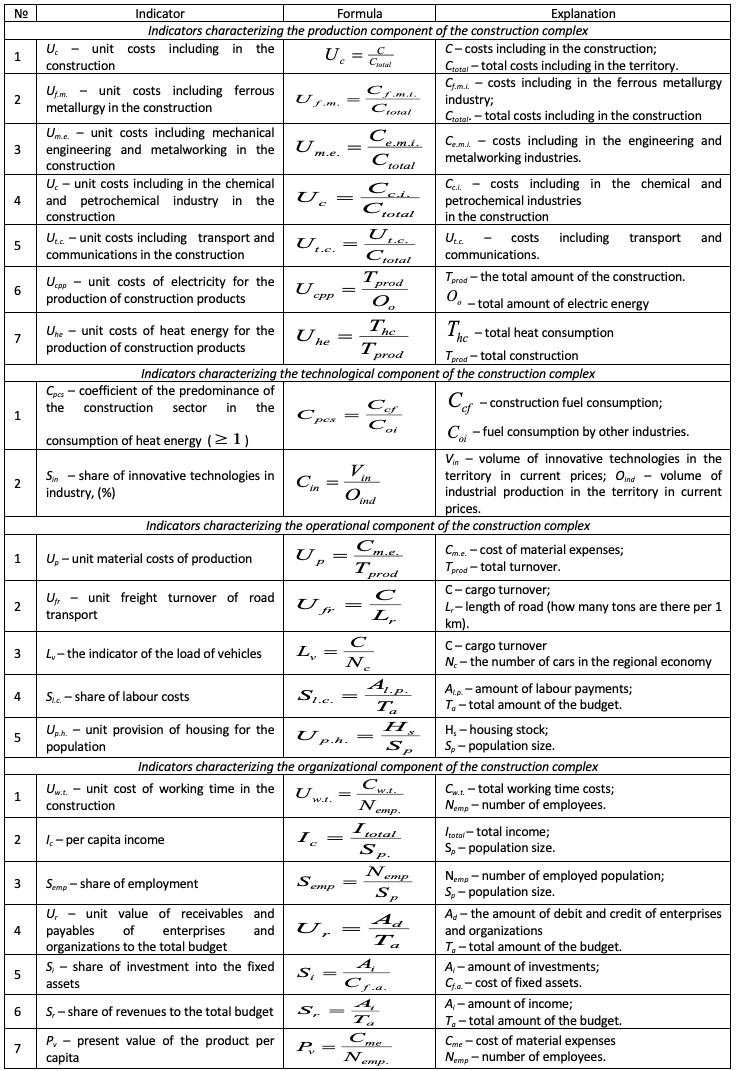
Compiled by the authors on the basis of Zalunina, O. (2014)
The indicators characterizing the operational component allow defining a set of measures to ensure comfortable and trouble-free use of buildings for specific purposes during the regulatory period. An operational period has the most significant impact on the quality of the building, since it is the final and longest in time. At the same time, during the operation period, there may be drawbacks made during the design and construction. Operational services in this case should eliminate these shortcomings. The indicators characterizing the operational component are an additional mechanism in solving these problems.
The indicators characterizing the organizational component of the construction complex allow assessing the consistency of actions of the participants in the construction process. Such actions include task grouping and work coordinating, i.e. organizational component appears in the implementation of a number of functions: directing, coordinating and motivating.
The presented indicators characterizing the components of the construction complex will allow evaluating the development of the construction complex from point of view of differentiation and integration. Differentiation is based on conducting in-depth research on each component of the building complex. Integration is based on the study of the construction process from different sides and forms priorities for the influence of a procedure on the situation as a whole.
The presented indicators are divided into primary, which are obtained from statistical sources, and analytical which are calculated values allowing to measure growth, rise or decline.
At the third stage, it is necessary to analyse the regression dependence between the formed indicators characterizing the functioning of the construction complex of the country.
The presented indicators of the development of the construction complex (Table 2) are related to the period and duration of construction projects, i.e. there is a development trend. This makes it difficult to analyse them. The technique in which the author proposes an effective method of excluding a trend is presented in the paper by Jackson Sh. L. (2015). To exclude the trends from the time series into the calculation formula (1):
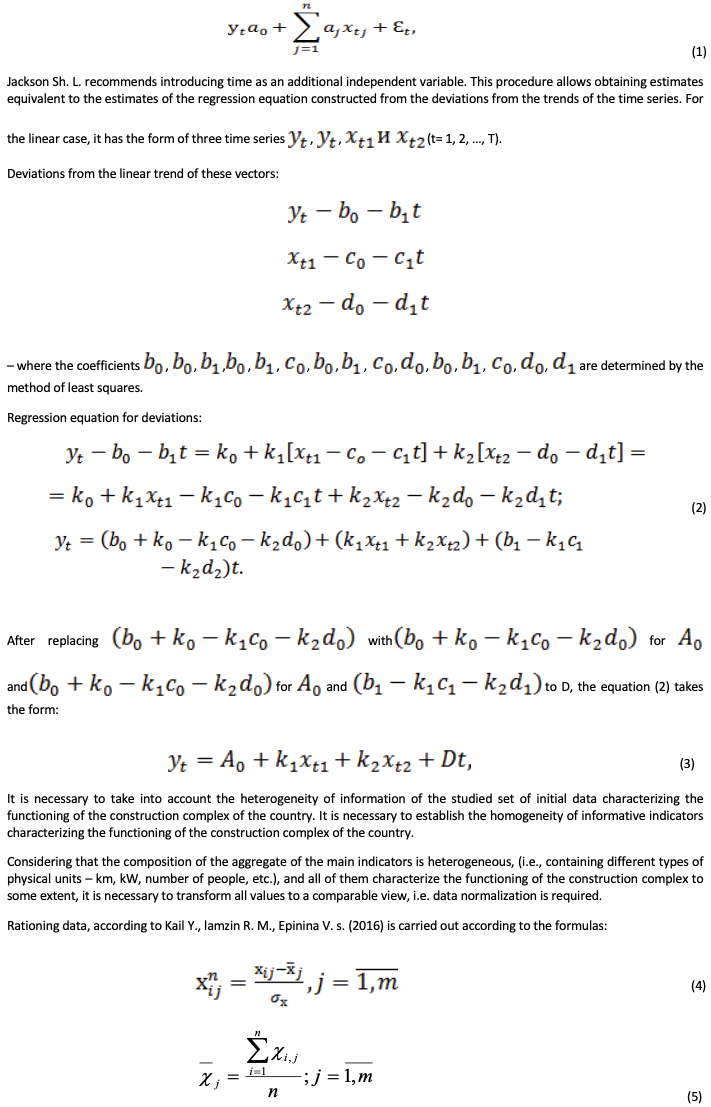
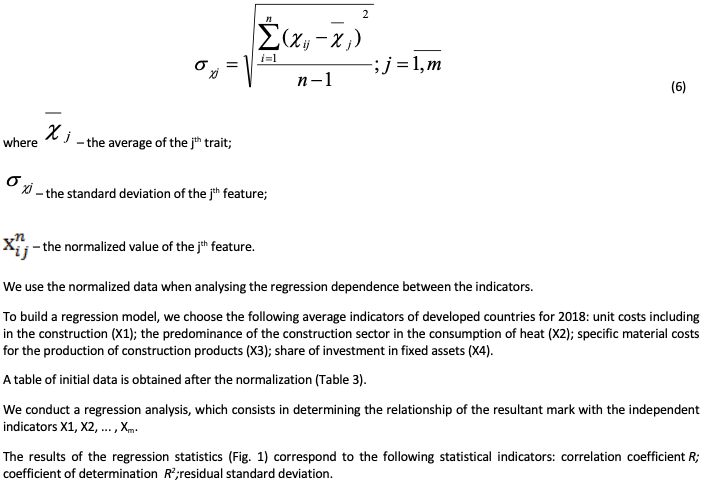
Table 3
Normalized raw data
period |
X1 |
X2 |
X3 |
X4 |
(month) |
||||
1 |
0.13 |
0.11 |
0.35 |
0.1 |
2 |
0.16 |
0.12 |
0.33 |
0.15 |
3 |
0.27 |
0.19 |
0.21 |
0.18 |
4 |
0.35 |
0.23 |
0.47 |
0.2 |
5 |
0.33 |
0.25 |
0.45 |
0.3 |
6 |
0.29 |
0.23 |
0.31 |
0.22 |
7 |
0.33 |
0.24 |
0.28 |
0.21 |
8 |
0.37 |
0.29 |
0.33 |
0.24 |
9 |
0.42 |
0.35 |
0.29 |
0.27 |
10 |
0.46 |
0.38 |
0.48 |
0.32 |
11 |
0.55 |
0.37 |
0.46 |
0.35 |
12 |
0.67 |
0.43 |
0.45 |
0.37 |
Source: compiled by the autors
The results of analysis of variance are generated in fig. (4-5) which are used to test the significance of the coefficient of determination R2.
Figure 1
Regression statistics results
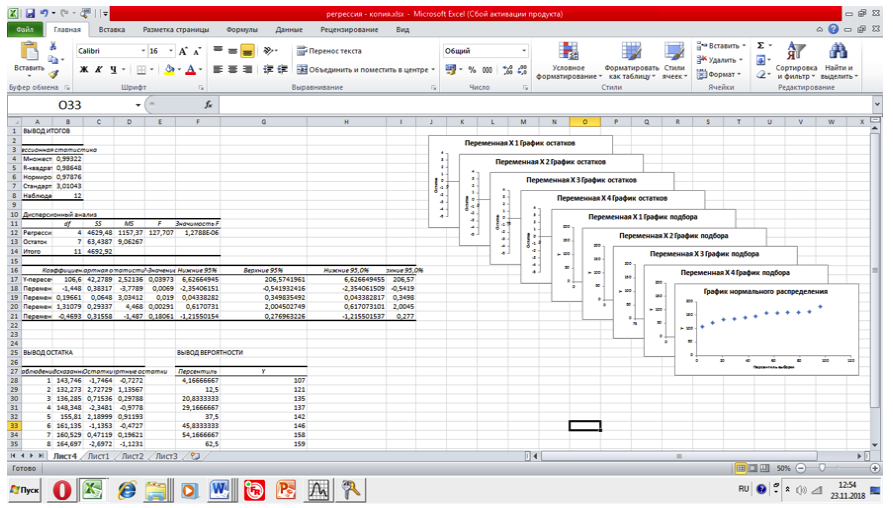
Source: compiled by the autors
-----
Figure 2
Variable selection charts
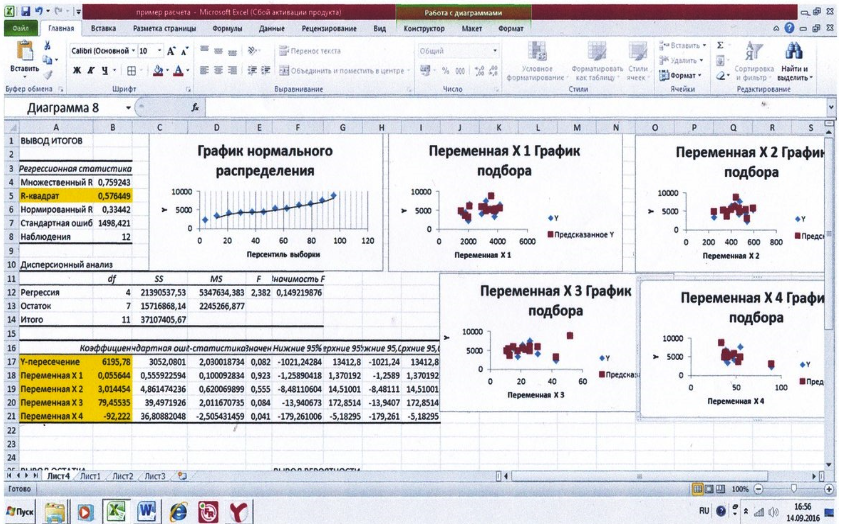
Source: compiled by the autors
-----
Figure 3
Graphics of variables
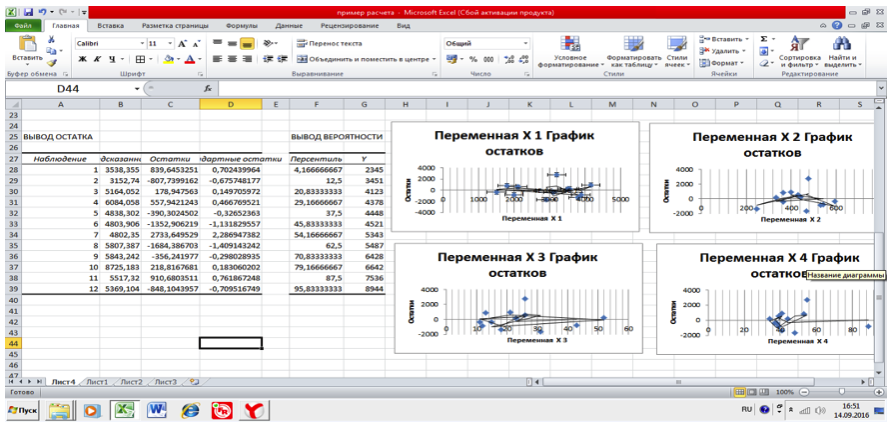
Source: compiled by the autors
As a result of the third stage, the author analyse the regression dependence of the indicators and justifies the expediency of the proposed approach. At the same time, based on regression dependencies, it is possible to establish the relationships in the functioning of the construction complex and to identify the dominant parameters of the development.
3.4. Formation of criteria for assessing the development of the construction complex of the country
At the fourth stage, it is necessary to form the criteria for assessing the development of the construction complex of the country, which qualitatively or quantitatively characterize the functioning of the construction (Fig. 4).
The criteria specify the indicators that characterize the functioning of the construction complex.
Figure 4
Criteria for assessing the development of
the construction complex of the country
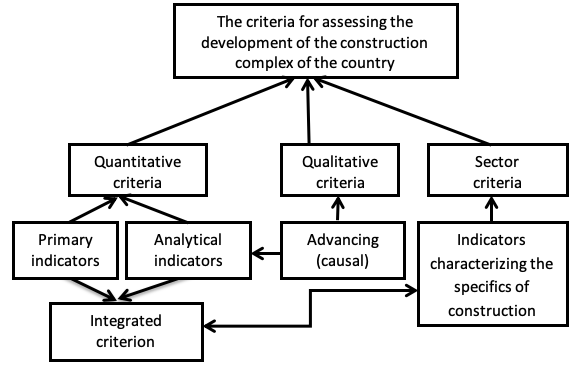
Source: compiled by the authors
The indicators are more dynamic. In one construction project, some indicators are used, but in another, some or most of them may be unacceptable due to changes in attributes. It depends on the complexity and scale of the specific tasks. The criterion is more stable, although it reflects the development.
It should be noted that the criterion is an assessment tool, but it is not an assessment itself. The criteria for assessing the development of the construction complex are closely interrelated and directly determine the choice of the necessary indicators. The integrated criterion performs a methodological function in relation to the indicators.
The criteria specify the indicators that characterize the functioning of the construction complex.
The indicators are more dynamic. In one construction project, some indicators are used, but in another, some or most of them may be unacceptable due to changes in attributes. It depends on the complexity and scale of the specific tasks. The criterion is more stable, although it reflects the development.
It should be noted that the criterion is an assessment tool, but it is not an assessment itself. The criteria for assessing the development of the construction complex are closely interrelated and directly determine the choice of the necessary indicators. The integrated criterion performs a methodological function in relation to the indicators.
Such an approach to the formation of the criteria for assessing the development of the construction complex allows, on the one hand, to determine its actual level, and on the other hand, to determine specific directions, ways, and conditions for development. It is also possible to evaluate the performance of the construction complex with their help.
The formation of the criteria for assessing the development of the construction complex is one of the most difficult categories, reflecting the relationship between factors and indicators.
Studies show that the assessment of the development of the construction complex is a complex and multifaceted process. The effective development of the building complex is carried out under the influence of the relevant conditions and factors, which can be assessed using the criteria. At the same time, the indicators characterizing the components of the building complex should reflect its level (pace), and the criteria – the direction of the changes taking place and meet the requirements of the progress in general.
A feature of the formation of the criteria for evaluating the construction complex is the relationship with the period, structure, methods of planning and control, the duration of construction projects, technical means, costs, and technologies. Therefore, it is advisable to structure the criteria for quantitative, qualitative and industry.
In empirical terms, the development of the construction complex can be represented as a process of changing construction objects that is gradual and corresponding to the coordinated stages. Moreover, in contrast to the functioning, the development of the construction complex implies both the reproduction of a new construction object and the process of the modernization of already existing construction objects.
As a result, the consistent implementation of the proposed stages makes it possible to formulate a methodical approach to determining the criteria for assessing the development of construction complex of the country.
Blaug, M. (2008) 100 Great Economists before Keynes, Saint Petersburg, Economus, 191-194.
Dougherty, C., and Dale W. J., (1996). International Comparisons of the Sources of Economic Growth, American Economic Association Papers and Proceedings, Vol. LXXXVI , pp. 25-29.
European Central Bank: www.ecb.europa.eu.
Gort, M. A. (1982). Model of diffusion in the production of an innovation, American Economic Review, 72, 5, 1111-1120. doi: 10.3386/w0297
Ivanova, Yu.V. (2011). Except Machiavelli: The Problem of the Method in Politics, Мoscow, Quadriga, 269-274.
Jackson Sh. L. (2015) Research Methods, Jacjsonville University, 480.
Johnston, R. E. (1966). Technical progress and innovation, Oxford Economic Papers, 18, 2, 158-176.
Kasych, A.O. (2011). Theoretical and methodical grounds for analysis of internal sources for financing of investment activity. Actual Problems of Economics, 3 (117), 243-250.
Kasych, A.О. (2013).The experience of national innovation systems' formation in developing countries. Actual Problems of Economics, 5 (143), 46-49.
Kail Y., lamzin R. M., Epininа V. s. (2016) Methods for analyzing and evaluating systems for public administration of socio-economic processes at the municipal level National Interests: Priorities and Security, 12 , 19–30.
Myrdal, G. (1972) Asian Drama an inquiry into the poverty of nations, Мoskow, Progress. 797.
Polat, G. (2010). Using ANP priorities with goal programming in optimally allocating marketing resources, Construction Innovation, 10, 3, 346–365.
Polat, G. and Donmez, U. (2010). ANP-based marketing activity selection model for construction companies, Construction Innovation, 10, 1, 89–111.
Seymour, D. Crook, D. and Rooke, J. (1997). The role of theory in construction management: a call for debate, Construction Management & Economics, 15, 1, 117–119.
Zalunina, O. (2014) Construction of aggregates of features of the building complex of the territory for conceptual grouping scheme, Eastern-european journal of enterprise technologies 4, 3(70), 29-33.
Zalunina, O. (2014) Structuring key economic indicators of the information field of the construction sector of Ukraine, Kremenchuk, Bulletin of the Kremenchuk National University named after Mikhail Ostrogradsky, 1, 52-59.
Zhao, Zuoquan. (2006). Discussion Papers on Entrepreneurship, Growth and Public Policy. A Spatial Model of Growth: Taking Technology Seriously, Max Planck Institute of Economics, Jena, Germany, 12.
Zombart, V. (2005). Selected works, Moscow, Territory of the Future, 324.
1. Associate of professor of Management Department, Kremenchuk Mykhailo Ostrohradskiy National University, Ukraine, e-mail: olvialavina@gmail.com
2. Head of Management Department, Kyiv National University of Technologies and Design, Ukraine, e-mail: kasich.alla@gmail.com
3. Associate of professor of Management Department, Kyiv National University of Technologies and Design, Ukraine, e-mail: lozzeika@gmail.com
4. Associate of professor of Management Department, Kyiv National University of Technologies and Design, Ukraine, e-mail: vsminfosn@gmail.com
5. Associate of professor of Management Department, Kyiv National University of Technologies and Design, Ukraine, e-mail: latahamasmi@gmail.com
[Index]
revistaespacios.com

This work is under a Creative Commons Attribution-
NonCommercial 4.0 International License